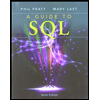1 Database Systems 2 Data Models 3 The Relational Database Model 4 Entity Relationship (er) Modeling 5 Advanced Data Modeling 6 Normalization Of Database Tables 7 Introduction To Structured Query Language (sql) 8 Advanced Sql 9 Database Design 10 Transaction Management And Concurrency Control 11 Database Performance Tuning And Query Optimization 12 Distributed Database Management Systems 13 Business Intelligence And Data Warehouses 14 Big Data Analytics And Nosql 15 Database Connectivity And Web Technologies 16 Database Administration And Security Chapter11: Database Performance Tuning And Query Optimization
11.1 Database Performance-tuning Concepts 11.2 Query Processing 11.3 Indexes And Query Optimization 11.4 Optimizer Choices 11.5 Sql Performance Tuning 11.6 Query Formulation 11.7 Dbms Performance Tuning 11.8 Query Optimization Example Chapter Questions Section: Chapter Questions
Problem 1RQ Problem 2RQ: What index should you create? Write the required SQL commands. Problem 3RQ: What is the focus of most performance-tuning activities, and why does that focus exist? Problem 4RQ: What are database statistics, and why are they important? Problem 5RQ: How are database statistics obtained? Problem 6RQ: What database statistics measurements are typical of tables, indexes, and resources? Problem 7RQ: How is the processing of SQL DDL statements (such as CREATE TABLE) different from the processing... Problem 8RQ: In simple terms, the DBMS processes a query in three phases. What are the phases, and what is... Problem 9RQ: If indexes are so important, why not index every column in every table? (Include a brief discussion... Problem 10RQ: What is the difference between a rule-based optimizer and a cost-based optimizer? Problem 11RQ Problem 12RQ: What are some general guidelines for creating and using indexes? Problem 13RQ Problem 14RQ Problem 15RQ Problem 1P: SELECT EMP_LNAME, EMP_FNAME, EMP_AREACODE, EMP_SEX FROM EMPLOYEE WHERE EMP_SEX = 'F' AND... Problem 2P: Problem 1 and 2 are based on the following query: SELECT EMP_LNAME, EMP_FNAME, EMP_AREACODE, EMP_SEX... Problem 3P: Using Table 11.4 as an example, create two alternative access plans. Use the following assumptions:... Problem 4P: Problems 46 are based on the following query: SELECT EMP_LNAME, EMP_FNAME, EMP_DOB, YEAR(EMP_DOB) AS... Problem 5P: Problems 46 are based on the following query: SELECT EMP_LNAME, EMP_FNAME, EMP_DOB, YEAR(EMP_DOB) AS... Problem 6P Problem 7P: Problems 732 are based on the ER model shown in Figure P11.7. Problems 7-10 are based on the... Problem 8P: Problems 732 are based on the ER model shown in Figure P11.7. Problems 7-10 are based on the... Problem 9P: Problems 732 are based on the ER model shown in Figure P11.7. Problems 7-10 are based on the... Problem 10P: Problems 732 are based on the ER model shown in Figure P11.7. Problems 7-10 are based on the... Problem 11P: Problems 1114 are based on the following query: SELECT P_CODE, SUM(LINE_UNITS) FROM LINE GROUP BY... Problem 12P: Problems 1114 are based on the following query: SELECT P_CODE, SUM(LINE_UNITS) FROM LINE GROUP BY... Problem 13P: Problems 1114 are based on the following query: SELECT P_CODE, SUM(LINE_UNITS) FROM LINE GROUP BY... Problem 14P: Problems 1114 are based on the following query: SELECT P_CODE, SUM(LINE_UNITS) FROM LINE GROUP BY... Problem 15P: Problems 15 and 16 are based on the following query: SELECT P_CODE, P_QOHP_PRICE FROM PRODUCT WHERE... Problem 16P: Problems 15 and 16 are based on the following query: SELECT P_CODE, P_QOHP_PRICE FROM PRODUCT WHERE... Problem 17P: Problems 1721 are based on the following query: SELECT V_CODE, V_NAME, V_CONTACT, V_STATE FROM... Problem 18P: Problems 1721 are based on the following query: SELECT V_CODE, V_NAME, V_CONTACT, V_STATE FROM... Problem 19P Problem 20P Problem 21P: Problems 1721 are based on the following query: SELECT V_CODE, V_NAME, V_CONTACT, V_STATE FROM... Problem 22P: SELECT P_CODE, P_DESCRIPT, P_PRICE, P.V_CODE, V_STATE FROM PRODUCT P, VENDOR V WHERE P.V_CODE =... Problem 23P: Problems 2224 are based on the following query: SELECT P_CODE, P_DESCRIPT, P_PRICE, P.V_CODE,... Problem 24P: Problems 2224 are based on the following query: SELECT P_CODE, P_DESCRIPT, P_PRICE, P.V_CODE,... Problem 25P: Problems 25 and 26 are based on the following query: SELECT P_CODE, P_DESCRIPT, P_QOH, P_PRICE,... Problem 26P: Problems 25 and 26 are based on the following query: SELECT P_CODE, P_DESCRIPT, P_QOH, P_PRICE,... Problem 27P Problem 28P: Problems 27 and 28 are based on the following query: SELECT P_CODE, P_DESCRIPT, P_QOH, P_PRICE,... Problem 29P: Problems 2932 are based on the following query: SELECT CUS_CODE, MAX(LINE_UNITSLINE_PRICE) FROM... Problem 30P: Problems 2932 are based on the following query: SELECT CUS_CODE, MAX(LINE_UNITSLINE_PRICE) FROM... Problem 31P: Problems 2932 are based on the following query: SELECT CUS_CODE, MAX(LINE_UNITSLINE_PRICE) FROM... Problem 32P: Problems 2932 are based on the following query: SELECT CUS_CODE, MAX(LINE_UNITSLINE_PRICE) FROM... Problem 7RQ: How is the processing of SQL DDL statements (such as CREATE TABLE) different from the processing...
Related questions
Concept explainers
What is a stored procedure in a database , and how does it differ from a regular SQL query? Provide an example of a simple stored procedure.
Organized collection of structured information, or data, typically stored in a computer system.
Expert Solution
This question has been solved!
Explore an expertly crafted, step-by-step solution for a thorough understanding of key concepts.
Step 1: Concept of SQL Database
VIEW
Step 2: Explaining Stored Procedures and Differences between Stored Procedures and Regular SQL Queries
VIEW
Step by step
Solved in 3 steps









